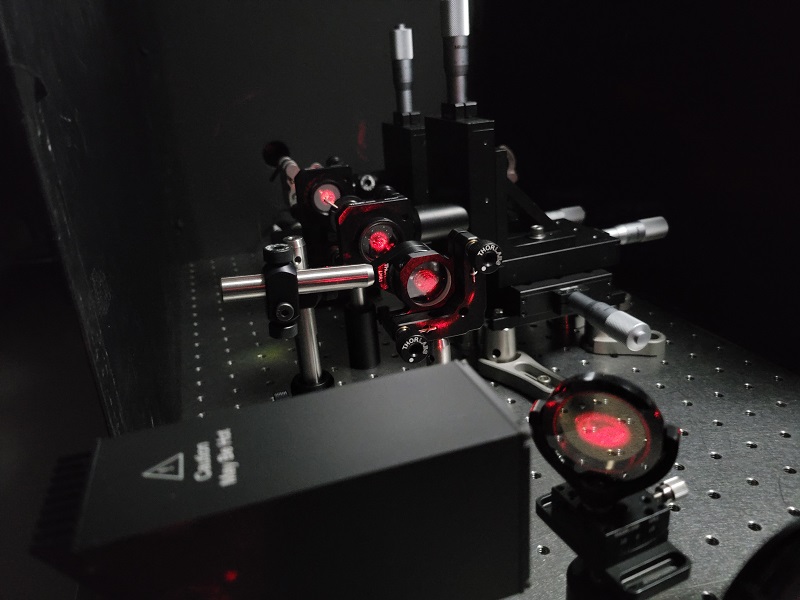
Light Trap Provides Near Perfect Absorption
Maximizing light absorption is essential for photovoltaics and many other photonic applications. It is also difficult, especially when the light is being absorbed by a thin layer of material that would normally allow a large portion of the light to pass through.
A way to achieve near-perfect light absorption, even with thin layers of material, has been developed through a collaboration between Vienna University of Technology (TU Wien) and The Hebrew University of Jerusalem.
“Absorbing light is easy when it hits a solid object,” TU Wien professor Stefan Rotter said. “A thick black wool jumper can easily absorb light. But in many technical applications, you only have a thin layer of material available, and you want the light to be absorbed exactly in this layer.”

The light trap, in which a beam of light prevents itself from escaping, allows near-perfect absorption of light. Courtesy of The Hebrew University of Jerusalem.
Using lenses and mirrors, the researchers created a near-perfect “light trap” around a thin layer of material. The light beam is steered in a circle and then superimposed on itself so that the beam blocks itself and can no longer leave the system.
One way to improve light absorption has been to place the absorbing material between two mirrors. As light is reflected back and forth between the mirrors, it passes through the material, creating an opportunity for the material to absorb more of the light with each pass. However, one mirror must be partially transparent; otherwise, the light cannot penetrate the space between the mirrors. Whenever the light hits the partially transparent mirror, some of it is lost.
“In our approach, we are able to cancel all back-reflections by wave interference,” said Ori Katz, a professor of applied physics at Hebrew University.
In the new light-trapping technique, the light first hits the partially transparent mirror. “If you simply send a laser beam onto this mirror, it is split into two parts,” said Helmut Hörner, a researcher at TU Wien. “The larger part is reflected. A smaller part penetrates the mirror.”
The portion of the beam that penetrates the partially transparent mirror is sent through the absorbing material layer and returned to this mirror via lenses and a different mirror. The length of the path and the position of the optical elements are crucial and are adjusted to ensure that the returning light beam — and its multiple reflections between the two mirrors — exactly cancels out the light beam reflected at the first mirror.

The 'light trap' setup is shown, consisting of a partially transparent mirror; a thin, weak absorber; two converging lenses; and a totally reflecting mirror. Normally, most of the incident light beam would be reflected. However, due to precisely calculated interference effects, the incident light beam interferes with the light beam reflected back between the mirrors, so that the reflected light beam is ultimately completely extinguished. The energy of the light is completely sucked up by the thin, weak absorber. Courtesy of TU Wien.
The two partial beams overlap in a way that essentially causes the light to block itself. The part of the beam that travels through the system before returning to the partially transparent mirror prevents the partially transparent mirror from reflecting any light.
Consequently, the mirror that was partially transparent becomes completely transparent for the incident laser beam, creating a “one-way street” for the light. The light beam can enter the system, but once it enters, it cannot escape because of the superposition of the reflected portion and the portion guided through the system in a circle.
In this way, an entire laser beam can be absorbed by a thin layer that would otherwise allow most of the beam to pass through.
“The system has to be tuned exactly to the wavelength you want to absorb,” Rotter said. “But apart from that, there are no limiting requirements. The laser beam doesn’t have to have a specific shape, it can be more intense in some places than in others. Almost perfect absorption is always achieved.”
The researchers demonstrated the robustness of the light-trapping system in experiments that showed that the system is not affected by air turbulence or temperature fluctuations.
Applications in light harvesting, energy delivery, light control, and imaging could benefit from this approach to trapping light. The light-trapping system could provide a practical way to feed lightwaves from weak light sources, such as distant stars, into a detector. It also has the potential to perfectly capture light signals that are distorted during transmission through Earth’s atmosphere.
The research was published in Science (www.science.org/doi/10.1126/science.abq8103).
Published: September 2022